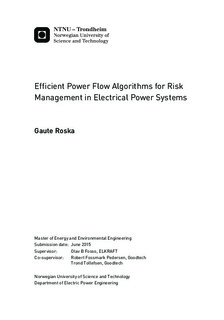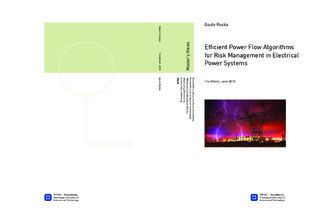| dc.description.abstract | Abstract
The society depends on a reliable electrical power system. The socio-economic cost will be high if a wide-ranging disruption of the supply occurs over an extended period of time. Thus programs that help system operators to identify possible risk in electrical power systems are needed.
The fast decoupled power flow, primal version, is found to have better convergence characteristic than the dual one, for power systems with a low X/R-ratio.
Linear sensitivity factors have been utilized in several of the algorithms. These factors are based upon DC and can be used to find post-contingency flows very fast, hence useful for decision support.
Contingency analysis is important in this report. The purpose of contingency analysis is to test systematically for outage of components like branches and generators. Most of the implemented code is contingency analysis algorithms.
The efficient bounding method has been implemented. This method encircles the outage component and thus reduces the number of calculations needed. The number of expansion steps needed from the outage, are dependent on an angle spread criterion concerning the boundary nodes. EBM is found to be faster than normal DC power flow. The concentric relaxation method is a simpler variant of the EBM. It utilizes a pre-determined number of layers to enclose an outage. The EBM and the CRM are best used when only the largest flow violations are of interest. Both the EBM and CRM are DC algorithms.
A post-compensation technique has been utilized for some of the algorithms, both AC and DC. This technique makes it possible to avoid time consuming factorization of matrices, thus allow for more calculations during a limited time frame. The post-compensation technique gives a more detailed output, and is faster than the EBM and the CRM. Even the AC-version used less time than the EBM when testing a large power system.
Indirect ranking of contingencies using a performance index has been implemented in the DC contingency analysis algorithms. A modification is done to the method so that only overloaded branches contribute to the index; hence it prevents the phenomena known as "masking error".
Efficient power flow algorithms are useful when time frame is limited. However, it is important to know the different algorithms' limitations. DC algorithms, for instance, should not be used for systems with a low X/R-ratio. | |

